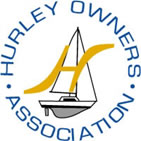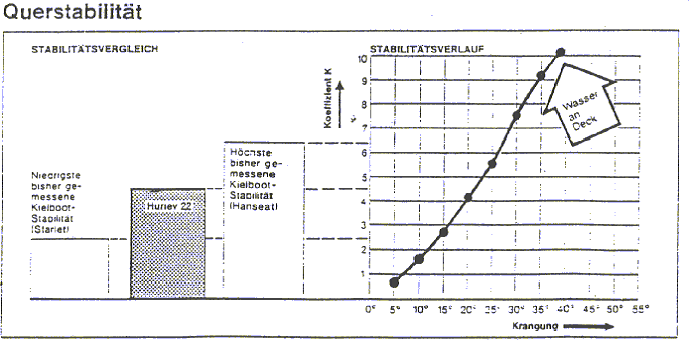


The YACHT TEST
from DIE YACHT 18/68
6.60-m-Plastic Yacht
Hurley 2

The Hurley 22 from England, from the board of Ian Anderson, can be seen as a successful design from sales alone. She looks like a real ocean-going yacht, though on boarding her, you will feel like a giant. But perhaps it is just the conservative but thoroughly effective design that attracts aficionados of the boat. After all, five boats per week were built by the English boat yard Hurley Marine Ltd. in Plympton, 50 % of these being for export. That the Hurley 22 has the behaviour of a bigger yacht on rough seas is shown in our test. Tester Lex Pranger said after some strong squalls under full sail: "You could call this boat your friend". And in fact the boat does give a comforting feeling of security even on rough coastal waters.
Typically English in her conception and construction the boat is very seaworthy. The test during a good Force 4 was really a great pleasure. This is exactly the wind force that the Hurley likes. She sails smoothly and dry, her motion in the waves is extremely good. The boat heels easily because of her slight form stability, but after an angle of a few degrees her large ballast ratio takes effect.
The Hurley is not a typical racer and in particular the optimal wind angle has to be judged carefully. Best results are not gained by forcing her too close to the wind, but with sheets eased slightly a good speed can be achieved. At 45° to the true wind and 35° to the apparent wind and with a wind speed of 9m/sec we made 4.6 knots. This is not a bad result. Close to 45° may be the optimal angle to windward. Her fastest course was at 95° to the true wind and she made 5.9 knots. This might well be hull speed since the same speed was achieved with the Force 4 wind aft. Well, back to windward, let's look, what will happen with the leeway at her best angle. We frequently took compass bearings over the stern and noted that she had very little visible tendency to leeway. The Hurley manages the waves brilliantly and this contrib-utes to the lack of leeway. Here again the boat shows the character of a small ocean-going yacht.
We sailed a 1966 model, which was equipped with a balance rudder. We saw once again, that a free hanging balance rudder does not give good handling characteristics. Because the rudder was mounted too near to the keel, eddies caused by the disturbed water flow became noticeable and were felt through the tiller. Our tests also showed that her course stability was not good either on the wind or with wind aft. In other words this older model does not hold her course well. Then we thought that the boat would turn faster with the balance rudder. Nothing of the sort, the Hurley turned like a lazy old lady. The fastest 360° turn took 25 seconds, but on the other hand the turning circle was small. Surely there must be something positive to say about this rudder? Indeed: When she goes straight on a quay you can push the rudder right over and this makes an excellent brake.
Naturally all this is only a question of experience and the skipper will quickly learn to handle the Hurley rudder. A test crew only has a boat for a short time and can't learn all tricks immediately. But the fact that Ian Anderson has now designed a rudder with skeg shows that our remarks are correct. The Hurley 22 is now only delivered with a skeg-hung rudder.
Mast and shrouds are solid as is essential for a cruising yacht. There was some trouble with the mast in recent years, for example during the One-of-a-kind-rally when a Hurley lost her mast. Going the mast got a new profile and a better tabernacle. On our test boat the mast was well rigged and these problems should be things of the past.
Now we would suggest changing the rig a little in accordance to our drawing to give the boat a higher po-tential of speed. With a bigger staysail triangle and a narrower main sail better sailing properties might be achieved. Nothing of the kind - we hear people shouting now - we don't want our yachtswomen to injure their hands when pulling the foresail sheet! Even for the sensitive hands of ladies it is no problem to tighten with the fair winches of the Hurley. With such a racing rig sailing is still very comfortably. And nevertheless it is certainly not understandable why nearly all coastal cruisers are under-rigged. Anyhow on 90 % of sailing days only moderate to weak winds blow and if it is blowing more once you can put in another reef. Finally nobody wants to hang in the pond like a plump duck when others can cruise speed-ily in little winds.
The Hurley can be reefed quickly and easily, the roller-reefing boom works faultlessly.
The shrouds, fittings and chain plates are made of stainless steel and the blocks are of Tufnol. Therefore the rig and all the fittings should be more or less maintenance free. The GRP hull is of solid lay-up and sturdily built, which is only to be expected from such an experienced yard. Because it is built to Lloyd's specifications it has the necessary reinforcements at those points where greater stress is to be expected. The deck surface is non-skid and should be easy to keep clean. It was surprising that our worn out test boat looked quite well kept.
The cockpit is not exactly spacious but it is comfortable and gives a good view forward. Leading the mainsail sheet from the end of the boom to a traveller on the aft deck is good and does not cramp the cockpit space.
The outboard in the well is easy to handle out of the cockpit and through the hatch of the aft deck. We tested the Hurley with a Seagull. We stated: much noise and many vibrations. It would be better to install a quieter two-stroke motor or to isolate the lazaretto with sound-absorbing material and to slip a rubber sheet under the traverse. Nevertheless we are of the opinion that an outboard is the ideal drive for a boat of this size.
The weight is well distributed to carry the motor aft. The stern has a good run-off and the transom does not drag through the water.
Speed and Optimal Angle to Windward

The speed curve shows that the optimal angle to windward is nearly 45°
to the true wind, that means 35° to the apparent wind. By decreasing
this angle the speed decreases in-stantly. The goal speed to windward
at the optimal angle and a wind speed of 9 m/sec is 6.5 nm in 2 hours.
We made the maximum speed of 5.9 knots at an angle of 95° to the
true wind. However the speed is very constant on downwind courses and
doesn't change until she turns to a windward course. The goal speed
to downwind was 11.4 nm in 2 hours. On downwind courses it is possible
to steer the boat right down, tackling to downwind gives no advantage
in speed.
Sailing properties concluded: not complicated on all downwind courses,
sensitive on wind-ward courses.
Lateral Stability

During the stability test the stability is measured*, which is specified by the design of the hull, weight of the hull and the ballast of 1 t. The more stability the boat has the more wind pressure she can endure.
The average of stability (the medium of the values between 5° and 35°) is used to compare the stability in the left diagram. (That means the comparison between the minimal ever measured keel boat stability ("Starlet") and the maximal ever measured keel boat stability ("Hanseat")).
The curve in the right diagram is very instructive as well. You can see the heeling range where the boat is exceptionally stiff.
The
Hurley is one of the stiffest boats we have ever tested, which is caused
by her big ballast ratio of more than 50 %. Yet, the initial stability
is not very big, but when she is heeling more than 15° her weight
of keel is becoming noticeable. It might be very difficult to heel the
boat more than 35°. Caused by her almost not existing form stability
the Hurley will always sail lightly heeled. That is not a handicap,
but heeled between 15° and 20° she has her best sailing qualities.
________________________
* If you are interested in how the test, the measurements and the calculations
were exe-cuted, you can order an instructional pamphlet where this is
explained.
(Comment by the translator: Unfortunately that leaflet has not been
archived by the pub-lisher.)
Change of Design

The test crew would change the hull and the sailing plan of the Hurley 22 in this way:
The
free-hung rudder (1) got a skeg and a changed form (2) by the yard in
the meantime, thus a substantially better rudder effect has been achieved.
To minimize the wet surface and to obtain a straight break edge the
keel could be retracted aft. By that the boat would turn easier (3).
Better racing qualities would be achieved if the mast was move to aft
(4) and if the main sail got a narrower cut (5). By this a bigger foresail
or genoa could be used.
________________
The cabin layout is a different story. Where the French tend to skimp, the English over-specify. An attempt has been made to accommodate a full two-room-equip in a very small space. We counted, and in total there are exactly 22 stowage areas on the Hurley. A big pot cupboard, a hanging wardrobe (in the latest version), a big galley with sink and an under cupboard are all well and good for the yachtswomen, but in our opinion they cramp the cabin space too much. It should be possible for two people to sit comfortably on both bunks, but this is only possible for those of less-than-ample proportions on the Hurley. But this too is a question of personal preference. It is certainly possible to store all pots and pans, to sleep four and to use the excellent sea-toilet easily. The cramped space is somewhat compensated for by the depth that the hull shape gives to the cabin, though there is no standing headroom; that would be asking too much on a boat of 6.70 m length.
By using a GRP internal moulding below decks the cabin looks smooth and clean. The extending chart ta-ble is a good size. There is plenty of stowage capacity for sails, fenders and ropes in the lockers, which have bulkheads and are accessible from the cockpit.
Conclusion
The Hurley 22 should be a good boat for yachtsmen looking for a small, low-maintenance coastal cruiser, which is able to handle a good blow. She sails well, but could be improved by changes to the rig and a modification of the hull according to a more modern design. The design is very solid und should guarantee a long life. The space below deck is limited, but gives enough stowage capacity and a roomy galley for the yachtswomen. All in all she is a seaworthy cruising boat in which a family of four could make a longer holiday cruise. The price is reasonable in view of the solid design.
_____________________________________________
Test
crew: Robbert Das, Ramon Gliewe, Lex Pranger
Drawings: Robbert Das, DIE YACHT
© of the German original text by Delius Klasing Verlag, Bielefeld, Germany
Translation by Hartmut Dietrich, Hamburg, with friendly special permission
of Delius Klasing Verlag, Biele-feld, Germany
Proof-read
by David Parkhill